欧盟新低电压LVD指令2014-35-EC简析
欧盟新LVD指令2014_35_EU和EMC指令2014_30_EU的新要求
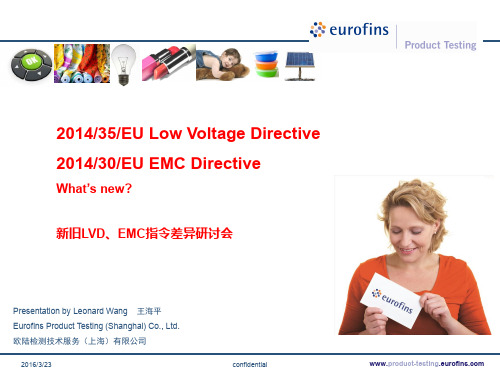
-‘making available on the market’ means any supply of electrical equipment for distribution, consumption or use on the Union market in the course of a commercial activity, whether in return for payment or free of charge; “在市场上供应”是指任何在市场上提供电气设备,用于分销、消费或者使用的商业行为, 既可以是免费提 供,也可以是收费提供。 任何在不同的经营者之间的货物流转,都认为是供货(making available)。
2016/3/23
confidential
Agenda
主要内容
Low Voltage Directive (LVD) 2014/35/EU 新低电压指令 Directive on Electromagnetic Compatibility (EMC) 2014/30/EU 新电磁兼容指令
5
LVD是低电压指令
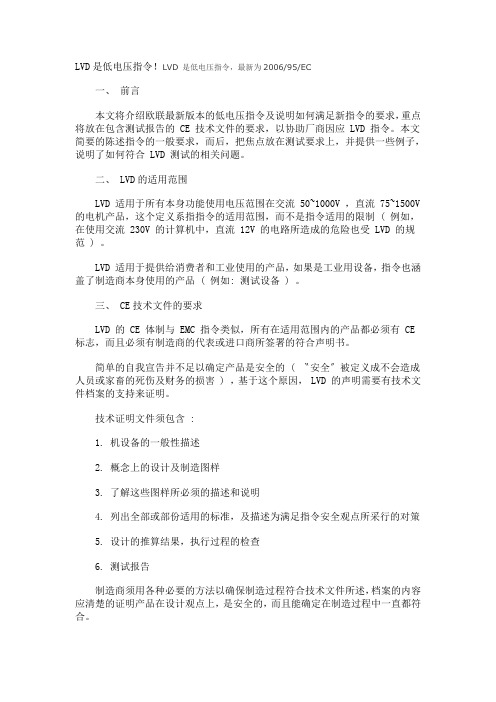
LVD是低电压指令!LVD 是低电压指令,最新为2006/95/EC一、前言本文将介绍欧联最新版本的低电压指令及说明如何满足新指令的要求,重点将放在包含测试报告的 CE 技术文件的要求,以协助厂商因应 LVD 指令。
本文简要的陈述指令的一般要求,而后,把焦点放在测试要求上,并提供一些例子,说明了如何符合 LVD 测试的相关问题。
二、 LVD的适用范围LVD 适用于所有本身功能使用电压范围在交流 50~1000V ,直流 75~1500V 的电机产品,这个定义系指指令的适用范围,而不是指令适用的限制 ( 例如,在使用交流 230V 的计算机中,直流 12V 的电路所造成的危险也受 LVD 的规范 ) 。
LVD 适用于提供给消费者和工业使用的产品,如果是工业用设备,指令也涵盖了制造商本身使用的产品 ( 例如: 测试设备 ) 。
三、 CE技术文件的要求LVD 的 CE 体制与 EMC 指令类似,所有在适用范围内的产品都必须有 CE 标志,而且必须有制造商的代表或进口商所签署的符合声明书。
简单的自我宣告并不足以确定产品是安全的 ( 〝安全〞被定义成不会造成人员或家畜的死伤及财务的损害 ) ,基于这个原因, LVD 的声明需要有技术文件档案的支持来证明。
技术证明文件须包含 :1. 机设备的一般性描述2. 概念上的设计及制造图样3. 了解这些图样所必须的描述和说明4. 列出全部或部份适用的标准,及描述为满足指令安全观点所采行的对策5. 设计的推算结果,执行过程的检查6. 测试报告制造商须用各种必要的方法以确保制造过程符合技术文件所述,档案的内容应清楚的证明产品在设计观点上,是安全的,而且能确定在制造过程中一直都符合。
建立安全设计较好的方法是,先表示符合所列出的调和标准,而以测试报告为证据。
调和标准会定期地发表在 EC 的官方公报 (Official Journal) 。
使用已受认可的文件 ( 如 EN 规格说明 ) 可以确定准备档案的这个人考虑了在其工业领域的最佳信息,而不只是他们自己的经验。
欧盟新版低电压指令自16年4月20日实施
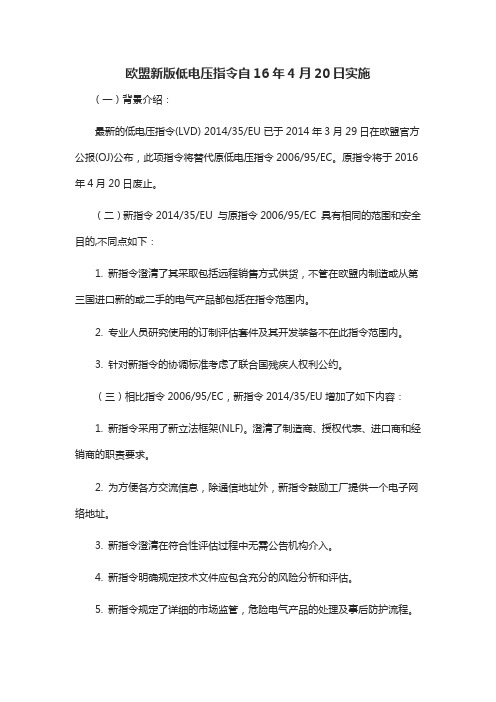
欧盟新版低电压指令自16年4月20日实施(一)背景介绍:最新的低电压指令(LVD) 2014/35/EU已于2014年3月29日在欧盟官方公报(OJ)公布,此项指令将替代原低电压指令2006/95/EC。
原指令将于2016年4月20日废止。
(二)新指令2014/35/EU 与原指令2006/95/EC 具有相同的范围和安全目的,不同点如下:1. 新指令澄清了其采取包括远程销售方式供货,不管在欧盟内制造或从第三国进口新的或二手的电气产品都包括在指令范围内。
2. 专业人员研究使用的订制评估套件及其开发装备不在此指令范围内。
3. 针对新指令的协调标准考虑了联合国残疾人权利公约。
(三)相比指令2006/95/EC,新指令2014/35/EU增加了如下内容:1. 新指令采用了新立法框架(NLF)。
澄清了制造商、授权代表、进口商和经销商的职责要求。
2. 为方便各方交流信息,除通信地址外,新指令鼓励工厂提供一个电子网络地址。
3. 新指令澄清在符合性评估过程中无需公告机构介入。
4. 新指令明确规定技术文件应包含充分的风险分析和评估。
5. 新指令规定了详细的市场监管,危险电气产品的处理及事后防护流程。
6. 新指令规定了当发现CE标志、CE符合性声明、技术文件或制造商信息不符合要求时,制造商和进口商应采取纠正措施纠正不符合项。
否则,相关成员国将采取措施限制或禁止产品在市场销售,并确保已销售产品从市场上被召回。
7. 依据新指令,成员国需制订适用于违反该指令相关的各成员国法律的惩罚规程,该惩罚规程包括严重违反时的刑事惩罚。
(四)重要日期1. 新LVD已于2014年3月29日在欧盟官方公报(OJ)上公布。
2. 此项指令将于2016年4月19日在成员国国家立法中生效并执行。
3. 新指令将于2016年4月20日取代现行指令2006/95/EC。
欧盟CE认证低电压指令申请有什么要求

欧盟CE认证低电压指令申请有什么要求欧盟CE认证低电压指令(Low Voltage Directive, LVD)是欧盟对低电压电气设备和产品的安全性要求的指令。
该指令适用于所有低电压设备和产品,包括供电电压在50V至1000V交流电或75V至1500V直流电范围内的设备和产品。
以下是关于LVD申请的要求的详细介绍。
1.有效性和执行力:LVD指令要求所有在欧洲市场销售的低电压设备和产品都必须符合指令的要求,并且必须获得符合性声明和CE标志。
2.产品定义:LVD指令适用于供电电压在50V至1000V交流电或75V至1500V直流电范围内的电气设备和产品,包括如家用电器、工厂设备、照明设备、电刷、开关、电缆等产品。
3.安全要求:LVD指令要求设备和产品满足欧洲统一的安全要求,以确保使用它们的人员和环境的安全。
具体要求包括但不限于:防止电击、火灾、短路和其他电气风险,合适的绝缘、耐久性和机械性能,电器和电子设备的EMC性能等。
4.CE标志:符合LVD指令的设备和产品必须被注明CE标志,并与性能声明或技术文件一起提供给经销商和消费者。
CE标志是欧洲市场的自愿性标志,表示产品符合欧洲指令的要求。
5.风险评估和技术文件:申请LVD认证的企业需要进行风险评估,以确定产品是否满足LVD指令的安全要求。
同时,企业还需要建立技术文件,包括产品的设计和制造信息、测试报告、安全评估报告等。
6.法定代表:欧洲外的企业在申请LVD认证时需要指定一个位于欧洲的法定代表。
法定代表负责代表企业处理与LVD认证相关的事务,并向欧盟成员国的市场监管机构提供必要的文件和信息。
7.与其他指令的关联性:LVD指令与欧洲其他指令有关联性,特别是与EMC指令的关系密切。
在申请LVD认证时,可能还需要满足其他指令的要求,如EMC指令、机械设备指令等。
8.本地市场监管机构的要求:LVD认证申请还需要向相关的市场监管机构提交必要的文件和信息,以证明产品符合LVD指令的要求。
低电压指令LVD

低电压指令LVD一、什么是低电压指令?欧洲议会和理事会2014年2月26日第2014/35 / EU号指令,关于统一成员国有关在市场上提供设计用于特定电压限制的电气设备的法律。
许多日常使用的电气产品要符合低压指令2014/35 / EU的基本健康和安全要求,该指令涵盖的电气设备,其额定电压在50V和1000V之间用于替代电流,在75V和1500V之间用于直流电;与其他CE指令一样,当电气产品投放市场时,本指令适用,电气产品要带有CE标志,以便在欧洲经济区(EEA)内自由交易。
通过在电气产品上粘贴CE标志,制造商或进口商确保产品符合低压指令2014/35 / EU的安全要求。
二、LVD指令范围内的产品:1.插座230 V供家庭使用2.家用灯具插头和插座3.设备耦合器-plugs,-outlets4.用于工业用途的器具耦合器5.器具耦合器,例如车辆加热器,即制造商制造的标6.电缆7.组件8.电源线插头+电缆+插座,带或不带无源元件9.电线套件和互连电线套件插头+电缆+电线套件10.安装外壳和导管11.多个旅行适配器12.带电源的多个旅行适配器(例如手机或音乐播放器的充电器)13.插头带有一个或多个插座,配有电子调光器或黄昏调光器14.带有集成插头和/或插座的产品,家用230V(例如手机充电器,夜灯)15.家用和类似固定电气装置的开关三、哪些产品不受低压指令2014/35 / EU指令的范围:1.用于爆炸性环境的电气设备2.放射学和医疗用电气设备3.货物和乘客电梯的电气部件4.电表5.家用插头插座6.电围栏控制器7.无线电干扰8.用于船舶,飞机或铁路的专用电气设备,符合成员国参加的国际机构制定的安全规定。
四、如何遵守低压指令2014/35 / EU低电压指令负责对制造商进行合格评定:制造商执行合格评定并以自己的方式记录评估,通常,符合性评估需要根据欧洲协调标准进行目视检查和测试,如果制造商不能或不愿意自己进行评估,他可能涉及三方机构,这些机构没有别的求;但是,制造商可能希望确保机构对其进行的测试和评估具有能力。
低电压指令LVD

低电压指令LVDLVD低电压指令Low Voltage Electrical Products低电压指令 (Low Voltage pirective, 73/23/EEC) 制订于1973年,为新方案 (New Approach) 指令制订前20年,并且被认为是新方案概念的前身。
LVD 的目标为确保低电压设备在使用时的安全性。
低电压设备的定义为额定电压为交流电时50到1000伏特间,直流电时75到1500伏特间的电气设备。
广义而言,低电压设备包含消费性产品及设计为在此电压范围内运作的设备。
包含家用电器、手工具、照明设备、电线、电缆及管线,以及配线设备等。
此指令包含此设备的所有安全规则,包括防护因机械原因造成的危险。
LVD指定欧盟会员国必须采取适当的方法,确保在国内市场中销售的电气设备不致危害人民安全,也不会危及国内动物或财产。
因此必须做到:设备必须依照安全守则,以良好方式进行设计设备必须正确装设及维护设备必须依设计目的使用如果设备符合所有会员国认可的特定安全规定,亦即符合这些条款。
在不影响其它形式证明下,可藉由参考规定良好设计方式的协同标准,证明其符合性。
LVD制订的时间早于CE标志成立时间。
CE标志即为近几年由欧盟草拟的这些新方案指令。
指令 93/68/EEC 修改了LVD,以符合现今的需求。
根据指令 93/68/EEC,制造厂商或欧盟内的授权代表可拟定一份符合性宣告,在产品上附加CE标志,标示其符合LVD及相关规定。
由产品上市时开始,制造厂商必须将技术文件保留10年,供相关单位进行检验之用。
符合性宣告的内容「符合性宣告」的一般内容可在指令的附录3(B) 查得。
详细说来,此项宣告必须包含:制造厂商或欧盟内授权代表的名称及地址电气设备说明协同标准参考必要时,必须包含制造厂商或其在欧盟内之授权代表宣告符合性时,所根据的详细说明参考文件授权委托之签署者的身份证明产品(首次)获得CE标志年份的最后两位数字符合性宣告必须以至少一种欧盟官方语言撰写。
关于欧盟CE指令更新几点须知

关于欧盟CE指令更新几点须知欧盟LVD指令2006/95/EC更新为2014/35/EU欧盟EMC指令2004/108/EC更新为2014/30/EU欧盟无线电及电信终端设备指令1995/5/EC更新为无线电设备指令2014/53/EU一、欧盟LVD指令2006/95/EC更新为2014/35/EU欧盟新版本LVD指令2014/35/EU于2014年3月29日在OJ(L96)上公布,代替旧LVD指令2006/95/EC,以适应NLF(新立法框架)的要求。
新指令增加了经济运营商义务,澄清了制造商或进口商的义务,以及对制造商的技术文档中要求增加产品风险评估文件等内容。
生效时间A. 2014/35/EU必须在2016年4月20日后执行,各欧盟成员国必须在2016年4月19日之前完成立法程序。
B. 基于旧LVD指令的VOC(符合性声明)自2016年4月20日起将不被接受;二、欧盟电磁兼容指令2004/108/EC更新为2014/30/EU欧盟新版本EMC指令2014/30/EU于2014年3月29日在欧盟官方期刊(L96/79)上公布,用以替换原有的电磁兼容指令2004/108/EC。
新指令新增“制造商”、“进口商”、“分销商”和“授权代表”等定义;新增经营者责任要求、制造商和进口商的名称,注册商号或注册商标和地址必须出现在设备上,而当设备尺寸或设备性质不允许时可出现在包装或用户手册上,用户手册应包括器具用途和符合指令的使用方法等内容。
生效时间A. 2014/30/EU将于2016年4月20日起执行,各欧盟成员国必须在2016年4月19日前完成立法程序。
B.基于旧电磁兼容指令的VOC(符合性声明)自2016年4月20日起将不被接受。
三、欧盟无线电及电信终端设备指令1995/5/EC更新为无线电设备指令2014/53/EU欧盟新版本的无线电设备指令2014/53/EU于2014年5月22日在欧盟官方期刊(L 153/62)上公布,用以替换原有的无线电及电信终端设备指令1995/5/EC。
LVD低电压指令

LVD低电压指令低电压指令概念低电压指令制订于1973年,为新方案指令制订前20年,并且被认为是新方案概念的前身。
LVD的目标为确保低电压设备在使用时的安全性。
低电压设备的定义为额定电压为交流电时50到1000伏特间,直流电时75到1500伏特间的电气设备。
广义而言,低电压设备包含消费性产品及设计为在此电压范围内运作的设备。
此指令包含此设备的所有安全规则,包括防护因机械原因造成的危险。
何种产品属于低电压指令范围这里所谓的[低电压]非指3伏、5伏、或12伏。
依指令开宗明义第一条的说明:[本指令所称之“电气设备”,系指设计使用在交流电压50V~1,000V,及直充电75V~1,500V 之间的所有产品]。
例如:家电产品(EN60335)、灯具产品(EN60598)、视听产品(EN60065),信息产品(EN60950)、电性机械(EN60204)、量测仪器(EN61010)。
何种产品不属于低电压指令范围--适用于易爆环境下的电气设备;--设备为放射线及医疗室使用的仪器--货物、乘客信降机的电器零件;--电表;--家用插座、插头;--电网控制器--无线电电气干扰船只、飞机或铁路使用的特殊电气设备,符合有会员国参与的国际组织所制定的安全法规者低电压指令的要求欧盟成员国为了确保销售在本国的电器、电子产品不会危害国民、动植物及财产的安全,对于低电压的指令有以下的要求:--设备必须按照安全守则,以良好的方式进行设计--设备必须正确装设及维护--设备必须依照设计目的使用符合性宣告的内容--制造厂房及欧盟内授权代表的名称及地址--电气设备说明书--协同标准参考--必要时包含制造厂商在符合代表宣告符合性时,所根据的详细说明参考文件--授权委托之签署者的身份证明--产品(首次)获得CE标志年份的最后两位数字--符合性宣告必须以至少一种欧盟官方语言撰写技术文件内容--产品的一般说明--设计及制造图,以及组件、子组件、线路等的图解。
关于欧盟CE-LVD指令更新的相关说明
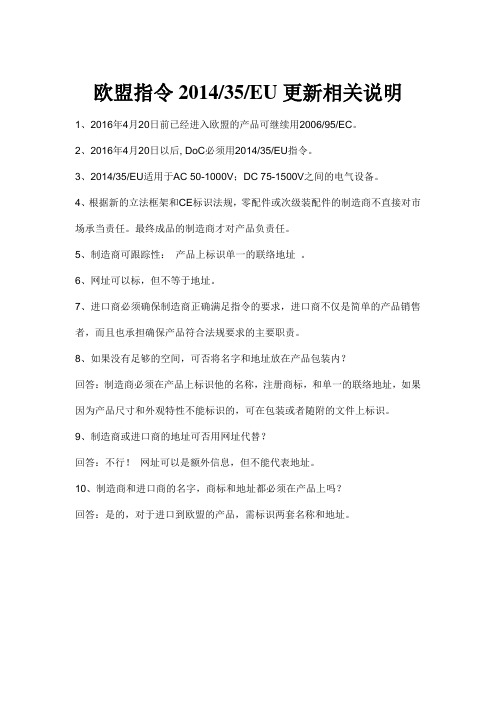
欧盟指令2014/35/EU更新相关说明
1、2016年4月20日前已经进入欧盟的产品可继续用2006/95/EC。
2、2016年4月20日以后, DoC必须用2014/35/EU指令。
3、2014/35/EU适用于AC 50-1000V;DC 75-1500V之间的电气设备。
4、根据新的立法框架和CE标识法规,零配件或次级装配件的制造商不直接对市场承当责任。
最终成品的制造商才对产品负责任。
5、制造商可跟踪性:产品上标识单一的联络地址。
6、网址可以标,但不等于地址。
7、进口商必须确保制造商正确满足指令的要求,进口商不仅是简单的产品销售者,而且也承担确保产品符合法规要求的主要职责。
8、如果没有足够的空间,可否将名字和地址放在产品包装内?
回答:制造商必须在产品上标识他的名称,注册商标,和单一的联络地址,如果因为产品尺寸和外观特性不能标识的,可在包装或者随附的文件上标识。
9、制造商或进口商的地址可否用网址代替?
回答:不行!网址可以是额外信息,但不能代表地址。
10、制造商和进口商的名字,商标和地址都必须在产品上吗?
回答:是的,对于进口到欧盟的产品,需标识两套名称和地址。
ce认证的产品分类

ce认证的产品分类摘要:一、前言二、CE 认证的概述三、CE 认证的产品分类1.低电压指令(LVD) 产品2.电磁兼容性(EMC) 产品3.机械指令(MD) 产品4.无线设备指令(RED) 产品5.个人防护设备指令(PPE) 产品四、CE 认证的重要性和意义五、结论正文:一、前言CE 认证是欧洲共同市场的一种强制性产品认证制度,旨在确保产品符合欧洲法规的基本安全和性能要求。
在我国,许多产品出口到欧洲都需要通过CE 认证。
了解CE 认证的产品分类有助于企业更好地应对欧洲市场的法规要求,为产品顺利进入欧洲市场奠定基础。
二、CE 认证的概述CE 认证,即“Conformité Européenne”,意为“欧洲一致性”。
它表明产品符合欧洲相关指令的基本安全和性能要求,可以在欧洲市场自由流通。
CE 认证制度涉及多个领域,包括低电压、电磁兼容性、机械、无线设备等。
三、CE 认证的产品分类根据不同的产品特性,CE 认证分为以下几类:1.低电压指令(LVD) 产品:低电压产品是指额定电压在50-1000V AC 或75-1500V DC 之间的产品。
这类产品包括家用电器、办公设备、工业控制设备等。
2.电磁兼容性(EMC) 产品:电磁兼容性产品是指在正常使用条件下,不会对无线电设备和电信设备产生不可接受的电磁干扰,且能抵抗来自其他设备的电磁干扰。
这类产品包括电子设备、信息技术设备、通信设备等。
3.机械指令(MD) 产品:机械指令产品是指在正常使用条件下,不会危及人员、动物或财产安全的机械产品。
这类产品包括机床、起重设备、输送设备等。
4.无线设备指令(RED) 产品:无线设备指令产品是指使用无线电波进行通信的设备,如手机、无线局域网设备、蓝牙设备等。
5.个人防护设备指令(PPE) 产品:个人防护设备指令产品是指为保护用户免受特定风险的个体防护设备,如安全帽、防护眼镜、防护手套等。
四、CE 认证的重要性和意义CE 认证是产品进入欧洲市场的通行证。
2014_35_EU-欧盟LVD新指令
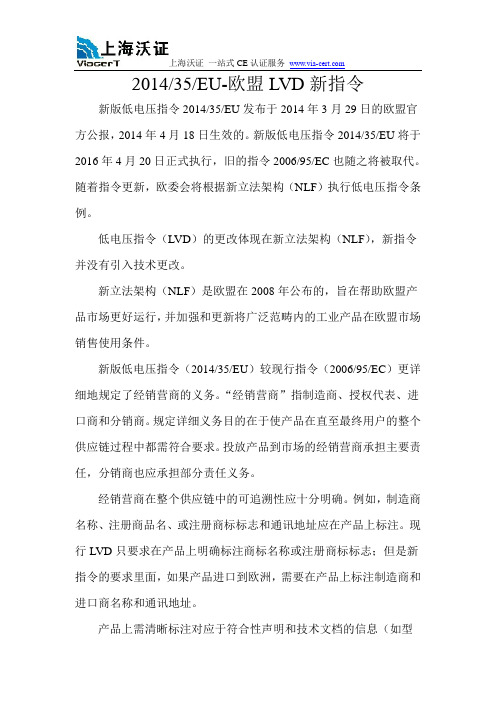
2014/35/EU-欧盟LVD新指令新版低电压指令2014/35/EU发布于2014年3月29日的欧盟官方公报,2014年4月18日生效的。
新版低电压指令2014/35/EU将于2016年4月20日正式执行,旧的指令2006/95/EC也随之将被取代。
随着指令更新,欧委会将根据新立法架构(NLF)执行低电压指令条例。
低电压指令(LVD)的更改体现在新立法架构(NLF),新指令并没有引入技术更改。
新立法架构(NLF)是欧盟在2008年公布的,旨在帮助欧盟产品市场更好运行,并加强和更新将广泛范畴内的工业产品在欧盟市场销售使用条件。
新版低电压指令(2014/35/EU)较现行指令(2006/95/EC)更详细地规定了经销营商的义务。
“经销营商”指制造商、授权代表、进口商和分销商。
规定详细义务目的在于使产品在直至最终用户的整个供应链过程中都需符合要求。
投放产品到市场的经销营商承担主要责任,分销商也应承担部分责任义务。
经销营商在整个供应链中的可追溯性应十分明确。
例如,制造商名称、注册商品名、或注册商标标志和通讯地址应在产品上标注。
现行LVD只要求在产品上明确标注商标名称或注册商标标志;但是新指令的要求里面,如果产品进口到欧洲,需要在产品上标注制造商和进口商名称和通讯地址。
产品上需清晰标注对应于符合性声明和技术文档的信息(如型号、序号批次)。
生产商需编制技术文档,只有依据该技术文件,才能评估电器设备是否符合相关要求。
同时,技术文件也包括风险评估以及针对风险所采取的必要措施。
生产商负责风险评估和针对具体风险采取的必要措施。
现行LVD没有明确注明产品需进行风险分析和评估。
在附件IV中,新版LVD引入了强制性符合性声明模板。
在相关当局需要时,制造商和授权代表或进口商必须能提供符合性声明。
另一个主要的变化是澄清了“制造商”的定义。
“制造商”指制造电器设备或以拥有其设计或制造得电器设备,并以其名称或商标在市场上销售该产品的自然人或法人。
传感器欧盟CE认证
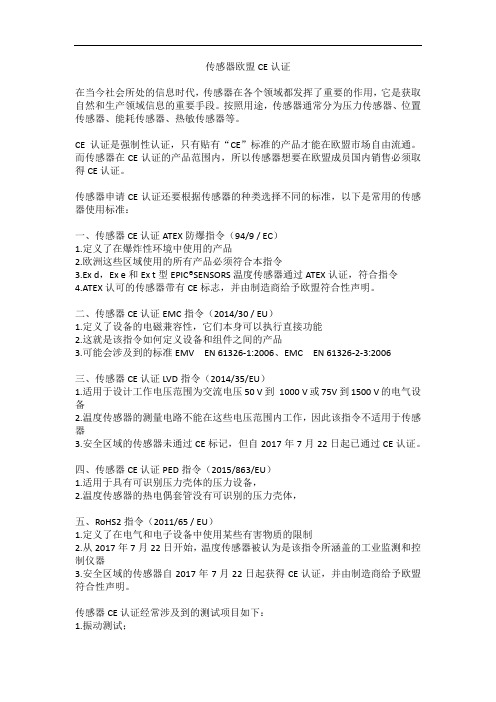
传感器欧盟CE认证在当今社会所处的信息时代,传感器在各个领域都发挥了重要的作用,它是获取自然和生产领域信息的重要手段。
按照用途,传感器通常分为压力传感器、位置传感器、能耗传感器、热敏传感器等。
CE认证是强制性认证,只有贴有“CE”标准的产品才能在欧盟市场自由流通。
而传感器在CE认证的产品范围内,所以传感器想要在欧盟成员国内销售必须取得CE认证。
传感器申请CE认证还要根据传感器的种类选择不同的标准,以下是常用的传感器使用标准:一、传感器CE认证ATEX防爆指令(94/9 / EC)1.定义了在爆炸性环境中使用的产品2.欧洲这些区域使用的所有产品必须符合本指令3.Ex d,Ex e和Ex t型EPIC®SENSORS温度传感器通过ATEX认证,符合指令4.ATEX认可的传感器带有CE标志,并由制造商给予欧盟符合性声明。
二、传感器CE认证EMC指令(2014/30 / EU)1.定义了设备的电磁兼容性,它们本身可以执行直接功能2.这就是该指令如何定义设备和组件之间的产品3.可能会涉及到的标准EMV EN 61326-1:2006、EMC EN 61326-2-3:2006三、传感器CE认证LVD指令(2014/35/EU)1.适用于设计工作电压范围为交流电压50 V到1000 V或75V到1500 V的电气设备2.温度传感器的测量电路不能在这些电压范围内工作,因此该指令不适用于传感器3.安全区域的传感器未通过CE标记,但自2017年7月22日起已通过CE认证。
四、传感器CE认证PED指令(2015/863/EU)1.适用于具有可识别压力壳体的压力设备,2.温度传感器的热电偶套管没有可识别的压力壳体,五、RoHS2指令(2011/65 / EU)1.定义了在电气和电子设备中使用某些有害物质的限制2.从2017年7月22日开始,温度传感器被认为是该指令所涵盖的工业监测和控制仪器3.安全区域的传感器自2017年7月22日起获得CE认证,并由制造商给予欧盟符合性声明。
ce认证指令与标准

ce认证指令与标准CE认证是欧洲共同市场的标志,表示该产品符合欧盟的安全、健康和环保要求,并可以自由销售和流通。
CE认证指令是用于CE认证的指令或法规,制定了相关的技术要求和程序。
以下是一些常见的CE认证指令和标准:1. 低压指令(Low Voltage Directive, LVD,2014/35/EU):适用于额定电压在50伏特至1000伏特之间的电气设备。
2. 机械设备指令(Machinery Directive,2006/42/EC):适用于机械设备的设计、制造和销售。
3. 压力设备指令(Pressure Equipment Directive,PED,2014/68/EU):适用于压力设备的设计、制造和销售。
4. 电磁兼容性指令(Electromagnetic Compatibility Directive, EMC,2014/30/EU):适用于电气和电子设备的电磁兼容性。
5. 红外线辐射指令(Infrared radiation directive,IRR,2006/25/EC):适用于工作场所中使用红外线辐射设备的安全。
6. 个人防护设备指令(Personal Protective Equipment Directive,PPE,2016/425/EU):适用于个人防护设备的设计、制造和销售。
7. 玩具安全指令(Toy Safety Directive,TSD,2009/48/EC):适用于玩具的安全性和标识要求。
8. 医疗器械指令(Medical Devices Directive,MDD,93/42/EEC):适用于设计、制造和销售的医疗器械。
这些指令都有具体的技术要求和程序,涉及产品设计、制造、测试和认证等环节。
为了符合CE认证要求,企业需要对产品进行测试和评估,并获得符合相关标准的认证证书。
LVD新指令2014_35_EU指导文件
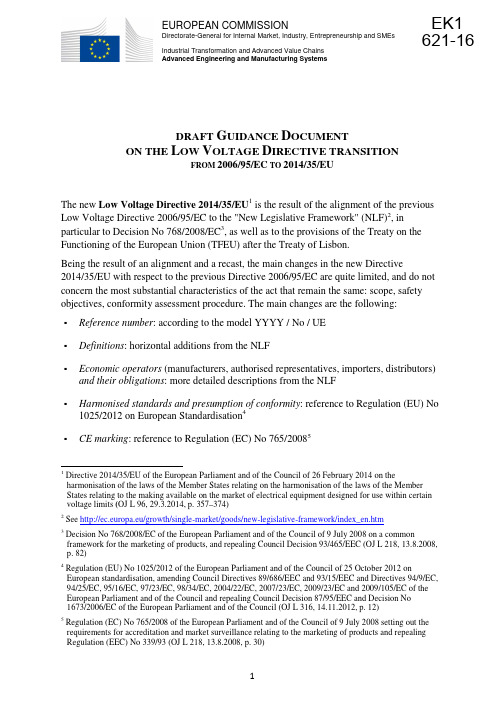
EUROPEAN COMMISSION Directorate-General for Internal Market, Industry, Entrepreneurship and SMEsIndustrial Transformation and Advanced Value Chains Advanced Engineering and Manufacturing SystemsDRAFT G UIDANCE D OCUMENTON THE L OW V OLTAGE D IRECTIVE TRANSITIONFROM 2006/95/EC TO 2014/35/EUThe new Low Voltage Directive 2014/35/EU 1 is the result of the alignment of the previous Low Voltage Directive 2006/95/EC to the "New Legislative Framework" (NLF)2, in particular to Decision No 768/2008/EC 3, as well as to the provisions of the Treaty on the Functioning of the European Union (TFEU) after the Treaty of Lisbon.Being the result of an alignment and a recast, the main changes in the new Directive2014/35/EU with respect to the previous Directive 2006/95/EC are quite limited, and do not concern the most substantial characteristics of the act that remain the same: scope, safety objectives, conformity assessment procedure. The main changes are the following:▪ Reference number : according to the model YYYY / No / UE▪ Definitions : horizontal additions from the NLF▪ Economic operators (manufacturers, authorised representatives, importers, distributors) and their obligations : more detailed descriptions from the NLF▪ Harmonised standards and presumption of conformity : reference to Regulation (EU) No 1025/2012 on European Standardisation 4▪ CE marking : reference to Regulation (EC) No 765/200851Directive 2014/35/EU of the European Parliament and of the Council of 26 February 2014 on theharmonisation of the laws of the Member States relating on the harmonisation of the laws of the Member States relating to the making available on the market of electrical equipment designed for use within certain voltage limits (OJ L 96, 29.3.2014, p. 357–374)2 See http://ec.europa.eu/growth/single-market/goods/new-legislative-framework/index_en.htm3Decision No 768/2008/EC of the European Parliament and of the Council of 9 July 2008 on a commonframework for the marketing of products, and repealing Council Decision 93/465/EEC (OJ L 218, 13.8.2008, p. 82)4Regulation (EU) No 1025/2012 of the European Parliament and of the Council of 25 October 2012 onEuropean standardisation, amending Council Directives 89/686/EEC and 93/15/EEC and Directives 94/9/EC, 94/25/EC, 95/16/EC, 97/23/EC, 98/34/EC, 2004/22/EC, 2007/23/EC, 2009/23/EC and 2009/105/EC of the European Parliament and of the Council and repealing Council Decision 87/95/EEC and Decision No 1673/2006/EC of the European Parliament and of the Council (OJ L 316, 14.11.2012, p. 12)5Regulation (EC) No 765/2008 of the European Parliament and of the Council of 9 July 2008 setting out the requirements for accreditation and market surveillance relating to the marketing of products and repealing Regulation (EEC) No 339/93 (OJ L 218, 13.8.2008, p. 30)EK1621-16▪Market surveillance and safeguard procedure: reinforced activities and new simplified procedures (also related to the "Product safety and market surveillance package"6)▪Electrical Equipment Committee and implementing acts: reference to Regulation (EU) No 182/20117 ("Comitology") concerning Commission Implementing Decisions onformal objections against harmonised standards and safeguard clauses against products ▪EU declaration of conformity: more detailed contents, and a model, from the NLFThe new Low Voltage Directive 2014/35/EU is applicable from 20 April 2016.This document includes a list of "Frequently Asked Questions and Answers" on the transition to the Low Voltage Directive 2014/35/EU, which covers both "horizontal" and "sectorial" questions, this is to say, those common to all the EU legislation aligned to the "New Legislative Framework"8 and those specifically related to Directive 2014/35/EU. It reflects the result of ongoing discussions, notably at the workshop on the transition to the new LVD 2014/35/EU held on 27October 2014.It should be noted that this document is preliminary, pending the revision of the Blue Guide and the LVD Guidelines. Upon finalisation of the revised Blue Guide (planned for end of 2015) and the LVD Guidelines (planned for mid-2016) the latter documents have to be considered as the main references for the interpretation of horizontal issues related to the New Legislative Framework and the LVD respectively.6 See http://ec.europa.eu/growth/single-market/goods/building-blocks/market-surveillance/organisation/index_en.htm7 Regulation (EU) No 182/2011 of the European Parliament and of the Council of 16 February 2011 laying down the rules and general principles concerning mechanisms for control by Member States of the Commission’s exercise of implementing powers (OJ L 55, 28.2.2011, p. 13)8Pyrotechnic Articles Directive 2013/29/EU (applicable 1 July 2015); Civil Explosives Directive 2014/28/EU, Simple Pressure Vessels Directive 2014/29/EU, Electromagnetic Compatibility Directive 2014/30/EU, Non-automatic Weighing Instruments Directive 2014/31/EU, Measuring Instruments Directive 2014/32/EU, Lifts Directive 2014/33/EU, ATEX Directive 2014/34/EU, Low Voltage Directive 2014/35/EU (applicable 20 April 2016); Radio Equipment Directive 2014/53/EU (applicable 13 June 2016); Pressure Equipment Directive 2014/68/EU (applicable 19 July 2016) and Marine Equipment Directive 2014/90/EU (applicable 18 September 2016). See http://ec.europa.eu/growth/single-market/goods/new-legislative-framework/index_en.htmFREQUENTLY ASKED QUESTIONS ON LVD 2014/35/EUTOPIC QUESTION REPLYPlace on themarketArticles 4, 6, 7, 8Difference between “placing on the market” and“making available on the market” in the frame of2014/35/EU (e.g. in Art. 4 making available is mentioned,but for the same activity when the responsibilities ofeconomic operators are covered – e.g. Art. 6, 7, 8 –placing on the market is mentioned)?'Making available' is the overall concept. Any transfer between economicoperators of a product is considered as making available. 'Placing on themarket' is a specific case of making available, namely it is the first time thatthe product is introduced on the market. It is important because at thatmoment the EU legislation applies. Any subsequent transfer is makingavailable.The operation is reserved either for a manufacturer or an importer, i.e. themanufacturer and the importer are the only economic operators who placeproducts on the market. When a manufacturer or an importer supplies aproduct to a distributor or an end-user for the first time, that operation islabelled in legal terms as placing on the market. Any subsequent operation,for instance, form a distributor to another or to an end-user is defined asmaking available.See also § 2.2. "Making available" and § 2.3. "Placing on the market" ofthe "Blue Guide"3In many cases products can be marketed through internet or other means but the product is not physically in the EU. Placing on the market requires the products to be physically in the EU territory? Union harmonisation legislation applies to all forms of selling. A product offered in a catalogue or by means of electronic commerce has to comply with Union harmonisation legislation when the catalogue or website directs its offer to the Union market and includes an ordering and shipping system. Products offered for sale online by sellers based outside the EU are considered to be placed on the Union market if sales are specifically targeted at EU consumers or businesses.See also § 2.1. "Product coverage" of the "Blue Guide"ManufacturerArticle 6.5 Type, batch or serial number:Does this Article mean that a product specification isrequired, but not necessarily a serial number? Wouldthere be a way to specify the sequential serial numberusing a barcode?The important point is that the numbering must allow making a clear link tothe relevant documentation that demonstrates the conformity of the specifictype of product, in particular the declaration of conformity.A barcode can also be used if this can reasonably be considered by amanufacturer as an appropriate way to identify and trace his products and tomake the link to the relevant documentation. Depending on the product, itis up to the manufacturer to decide whether the identification elementshould allow the identification of each single product or just the relevantbatch or type. But manufacturers should be aware that when publicauthorities recall products and it is not possible to distinguish betweenbatches or serial numbers, all products of that brand must be removed fromthe market.The Directive allows placing the information on the packaging or in adocument accompanying the electrical equipment if the size or nature ofthe electrical equipment does not allow it. Of course if the information is4not visible at a first sight, it must be easily and safely accessible. See also § 4.2.2.3. "Identification element" of the "Blue Guide"Article 6.6Name and address on the productIf lack of space, would be possible to indicate the nameand address within the product?The manufacturer must indicate his (1) name, (2) registered trademark and(3) a single contact postal address on the product or, when not possiblebecause of the size or physical characteristics of the product, on itspackaging and/or on the accompanying documentation.If the information is put inside the product, it must be easily accessible bythe Market Surveillance Authorities, without damaging the product or theneed for disassembling it with specific tools.See also §3.1. "Manufacturer" and §4.2.2.1. "The requirement to indicatename and address of the manufacturer" of the "Blue Guide"Must the information refer to the local distributor or theeconomic operator placing the product on the EU market?The information is related to the economic operator that places the producton the market i.e. the manufacturer or importer, not the distributor.In the case that a company is based in a third country andin an EU country, is necessary to put the information ofboth places as manufacturer and importer?If both, manufacturer and importer belong to the same group or companyand if the company based in the EU takes the full manufacturer'sresponsibility, the indication of the branch based in the EU will suffice tocomply with the requirements.5The postal address in which the manufacturer can be contacted, must be the one of the manufacturer? Not necessarily. The postal address must be "at which [the manufacturer] can be contacted": this is not necessarily the address where the manufacturer is actually established. This address can for example be the one of the authorised representative or of the customer services.See also § 4.2.2.1. "The requirement to indicate name and address for manufacturers" of the "Blue Guide"How to implement the requirement that the contact details shall be in a language easily understood? This provision refers to the use of alphabets. The address details do not have to be translated. The characters of the language must allow identifying the origin and the name of the company. This is not possible with certain alphabets.Article 6.7Instructions and safety informationWhat does mean ‘manufacturer’s documentation’ withinthe Low Voltage Directive?As Low Voltage Directive covers safety matters only,may any mandatory documentation relate to safety only? Instructions and safety information need to be provided, whether the product is intended for consumers or other end-users. The Low Voltage Directive does not make a distinction on who is the user of the product. The documentation should include all the necessary information for the safe use of the product, to enable the consumer to assemble, install, operate, store, maintain, repair, and dispose of the product.It is for the manufacturer to determine the relevant information which should be included in the instructions and safety information for a particular product.One single document can include both safety info and instructions.6Should each product sold in a bulk contain the instructions and safety information?May documents for products to be used most likely by professionals remain only in English? In principle, every individual product must be accompanied by the safety instructions but it does not mean that the full instructions must be given in paper. In some specific cases, where several identical products are bundled in a packaging for use in one application (e.g. installation equipment), it is sufficient to accompany the shipping unit with one set of instructions. If another economic operator along the distribution chain dismantles the bundle and sells the products individually, he should ensure that each product individually sold is accompanied by the necessary instructions and safety information.It is the national law that must indicate the languages required and if the use of English is allowed for specific uses.This item will also be clarified in the Blue Guide.See also § 3.1. "Manufacturer" of the "Blue Guide"Article 6.8The Directive requires that where the electrical equipmentpresents a risk, manufacturers shall immediately informthe competent national authorities.Which is the threshold of unacceptable risk above whichauthorities have to be informed? The acceptable level of risk for a product is determined by the compliance with the essential requirements. The essential requirements of the LVD have not been changed and therefore the previous thresholds for assessing the risks would continue to apply.7Importer Article 8.2“Before placing electrical equipment on the marketimporters shall ensure that the appropriate conformityassessment procedure has been carried out by themanufacturer. They shall ensure that the manufacturer hasdrawn up the technical documentation, that the electricalequipment bears the CE marking and is accompanied bythe required documents, and that the manufacturer hascomplied with the requirements set out in Article 6(5) and(6)”How do we interpret “the market importers shallensure”? Does it mean that the importers must have acopy of the declaration of conformity and the TechnicalDocumentation?The importer needs to have a copy of the declaration of conformity and hasto keep it for 10 years after a product has been placed on the market.The importer does not have to have a copy of the technical documentationbut has to ensure that the technical documentation can be made available tothe competent national authority upon request.Even if there is no explicit obligation, the importer is advised to requireformal assurance in writing from the manufacturer that the documents willbe made available when requested by the surveillance authority. But thetechnical documentation can be given directly by the manufacturer to thesurveillance authorities. What is important is that the authorities receive thedocumentation and that at importer's request the manufacturer provides theinformation to Member States.The importer also has to check the CE marking, labelling of the product,the identification number of the product, the contact details and that thecorrect conformity assessment procedure has been carried out.See also § 3.3 of the Blue Guide on the obligations of importersShould be the product accompanied not only by theinstructions for usage and safety but also by the CEdeclaration of conformity and/or technicaldocumentation?In the LVD context, the only document that has to accompany the productis the instructions and safety information.8Article 8.4“Importers shall ensure that the electrical equipment is accompanied by instructions and safety information in a language which can be easily understood by consumers and other end-users, as determined by the Member State concerned.”Can the product be imported with instructions only in English created by the manufacturer, and can the importer himself create a translation of the instructions that will accompany the product when is placed on the Union market? The Directive does not specify which economic operator has to translate the instructions and safety information. Manufacturers, importers and distributors have the obligation to ensure that the product is accompanied by instructions in a language which can be easily understood by consumers and other end-users, as determined by the Member State concerned.It is for each economic operator which makes available the product in a Member State, to ensure that all the languages are available. Nothing prevents economic operators from reaching contractual agreements on the manner in which they are translated.What happens if the product is placed on a market for which the manufacturer has not foreseen a translation? A manufacturer has a certain set of languages where he intends to ship the product but if it goes somewhere else, importer and distributor must ensure that instructions are translated in the relevant language. It depends on how economic operators are organised by contractual arrangements.What happens with bad translations? According to Article 6.7, instructions and safety information, as well as any labelling, shall be clear, understandable and intelligible and therefore bad translations will be considered as non-compliance.9Distributor Article 9.2“Before making electrical equipment available on themarket, distributors shall verify that the electricalequipment bears the CE marking, that it is accompaniedby the required documents and by instructions and safetyinformation in a language which can be easily understoodby consumers and other end-users in the Member State inwhich the electrical equipment is to be made available onthe market, and that the manufacturer and the importerhave complied with the requirements set out in Article6(5) and (6) and Article 8(3) respectively.”What exactly are the “required documents” that arementioned in this paragraph?The "required documents” that the distributor needs to make sure that arepresent are the ones which have to accompany the product, as described ineach aligned Directive.In LVD, besides the CE marking which the product needs to bear, therequired documents are only the instructions and safety information. Thedistributor does not have to have a copy of the Declaration of conformityor the Technical Documentation.See also § 3.4 of the Blue Guide.How do the distributors check if the requirements weremet except for the CE marking and the instructions ofusage and safety?The distributor must check that the manufacturer and importer haveindicated their name, registered trade name or trademark and the address atwhich they can be contacted on the product or when not possible becauseof the size or physical characteristics of the products, on its packagingand/or accompanying documentation and that the product bears a type,batch or serial number or other element allowing the identification of theproduct.10The distributor must be able to identify the manufacturer, his authorisedrepresentative, the importer or the person who has provided him with theproduct in order to assist the market surveillance authority in its efforts toobtain the EU declaration of conformity and the necessary parts of thetechnical documentation. Market surveillance authorities have thepossibility to address their request for the technical documentation directlyto the distributor. The latter, is however not expected to be in possession ofthe relevant documentation.Regarding the declaration of conformity, few electrical products fall onlyunder the LVD, normally they are covered by other Directives too. Whenseveral Directives regulate a product, the DoC should refer to all of themand the essential requirements. For this reason, when one product iscovered by several Directives for which the DoC must accompany theproduct, if the LVD applies as well, its reference should be included in the'global' DoC. This should be checked by the importer or distributor.In this regard, when some Directives apply, such as lifts, machinery orR&TTE, the LVD ceases to apply.Article 9.5“Distributors shall, further to a reasoned request from acompetent national authority, provide it with all theinformation and documentation in paper or electronicform necessary to demonstrate the conformity of electrical equipment. They shall cooperate with that authority, at its request, on any action taken to eliminate the risks posed by electrical equipment which they have made available on the market.” There is not specific time limit in the Directive for a "reasonable period". This period has to be assessed by the authorities on a case-by-case basis, taking into account the level of urgency/seriousness of risk and the efforts for the economic operator to follow-up the request. A default period could be e.g. 10 working days, but giving the possibility to shorten it or extend depending of the case. Member States are free to fix a default period inWhat is a reasonable period for the distributors to provide the necessary documents, taking in account the fact that even the smallest distributor should provide the information? their national laws, but there should always be a possibility to shorten or prolong that period.Harmonised standards Article 12List of harmonised standardsWhat would happen with the list of LVD harmonisedstandards if in the date of applicability of the newDirective new standards are not published?The LVD mandate requests CENELEC to provide the list of harmonisedstandards two months before the date of applicability of the new Directive.If the list of harmonised standards referring to the new Directive is notpublished in time, the mandate and Article 27 of the new LVD state that thereferences to the repealed Directive shall be construed as references to thenew Directive. Therefore, references to the existing LVD would givepresumption of conformity with the safety objectives of the new Directive2014/35/EU, because they remain the same.Are LVD harmonized standards going to content anAnnex ZA indicating the safety objectives covered by thestandard?The LVD mandate request CENELEC to include the Annex ZA only innew or revised standards, 12 months after the date of application of the newDirective.The annex ZA template will be unified for all New Legislative FrameworkDirectives and ESOs taking into consideration the Directives particularities.Declaration of conformityArticle 15.2Article 15.1 Article 15.2 TranslationIs the translation of the EU declaration of conformitymanufacturer's responsibility when he markets theequipment under his name or trade mark?Can the importer translate the declaration before heplaces the product on the market or can the distributortranslate it before making it available on the market andprovide the translation together with the EU declarationof conformity of the manufacturer which is for examplein English?Union harmonisation legislation does not necessarily specify who has theobligation to translate.It must be considered that, in the LVD, just the manufacturer or theimporter has to have a copy of the DoC. There can be a contractualarrangement between the manufacturer and the importer about who doesthe translation. It should be noted that there is a compulsory template of theDoC in Annex IV, which is translated in the OJEU in all EU languages.Must the translations of the declaration of conformity besigned by the manufacturer?The EU declaration of conformity must be signed by the manufacturer (byan individual working for the manufacturer) or his authorisedrepresentative, and the employee's function shall also be indicated.If a translation of the EU declaration of conformity is not signed by themanufacturer, a copy of the original EU declaration of conformity signedby the manufacturer must be provided together with the translated version. Information to be includedWhich information must be included in the declaration ofconformity?If a manufacturer produces a declaration of conformity that follows strictlythe template set out in Annex IV, he will completely fulfil the requirementsof the declaration of conformity. The reference in Annex III does not addany additional requirement. Additional information can be included.Article 15.3Reference to the new LVDFrom what date a manufacturer has to mention the newdirectives for his EU declaration of conformity (DoC)? Before 20 April 2016 all the EC declarations of conformity for LVD products placed on the EU market must be in line with Directive2006/95/EC. According to Article 25, products that are already in the distribution chain before 20 April 2016 (including stockpiles: see Recital 36) can continue to be made available on the EU market with this EC declaration of conformity referring to Directive 2006/95/EC as they have already been lawfully placed on the market. Declarations of conformity (EC or EU) remain valid according to the legislation in force when the product is placed on the market (= made available on the EU market for the first time). There is no need to change legislative references in documents accompanying the product.For LVD products placed on the EU market as of 20 April 2016 the EU declaration of conformity must be in accordance to the new LVD2014/35/EU by that date.Although in the LVD case, the DoC does not have to accompany the product, electrical equipment must comply with other EU legislation and the DoC accompanies often the product. In order to facilitate the transition to the new Directive 2014/35/EU, the EU declaration of conformity can indicate the following: “The object of the declaration described above is in conformity with the relevant Union harmonisation legislation: Directive 2006/95/EC (until April 19th, 2016) and Directive 2014/35/EU (from April 20th, 2016).”Equipment presenting arisk Article 19What is the purpose of Article 19 which describes theprocedure to deal with electrical equipment presenting arisk at national level?Article 19 describes the procedure for products presenting a risk.If upon request of the market surveillance authority (MSA), the economicoperator agrees to take the necessary corrective action (voluntary measuresby the operator), the procedure ends here. In this case, if the MSA considerthat the risk goes beyond the national territory, they will inform theCommission and other Member States (MS) of the results of the evaluationand the actions the economic operator intends to take.However, if the economic operator does not take corrective action asrequested by the MSA, the MSA shall take appropriate measures againstthe product (compulsory measures). In this case, the national authoritiesnotify the measure to the Commission and other MS, who have thepossibility to object to it during a 3-month period. If no objection is raised,the measure is deemed to be justified. In this case all Member States areobliged to take appropriate action against the product on their territories.If objections are raised, the Commission needs to take a decision todetermine whether the measure should be considered as justified or not(Union safeguard procedure in Article 20).The purpose is that restrictive measures against the product are not anunjustified restriction of the free movement of goods. Additionally, is aninformation-sharing tool between MSAs. This exchange of information,although non-compulsory in the phase of voluntary corrective actions, isalso expected to be submitted by the MSA to other MS.The safeguard clause procedure has not changed and must be applied in。
lvd低电压指令标准
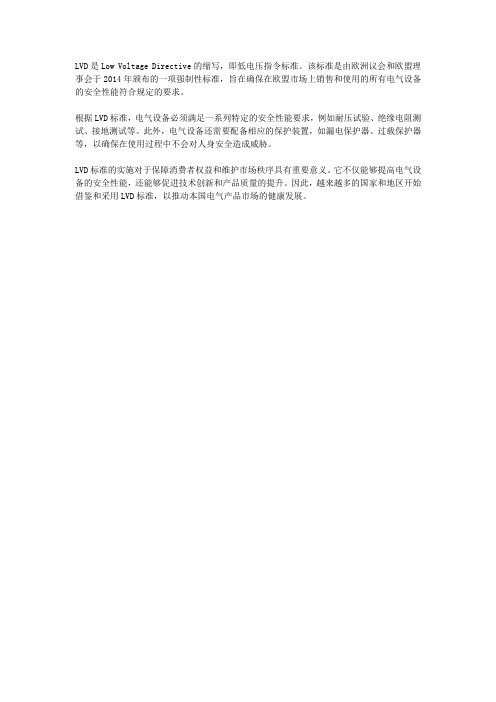
LVD是Low Voltage Directive的缩写,即低电压指令标准。
该标准是由欧洲议会和欧盟理事会于2014年颁布的一项强制性标准,旨在确保在欧盟市场上销售和使用的所有电气设备的安全性能符合规定的要求。
根据LVD标准,电气设备必须满足一系列特定的安全性能要求,例如耐压试验、绝缘电阻测试、接地测试等。
此外,电气设备还需要配备相应的保护装置,如漏电保护器、过载保护器等,以确保在使用过程中不会对人身安全造成威胁。
LVD标准的实施对于保障消费者权益和维护市场秩序具有重要意义。
它不仅能够提高电气设备的安全性能,还能够促进技术创新和产品质量的提升。
因此,越来越多的国家和地区开始借鉴和采用LVD标准,以推动本国电气产品市场的健康发展。
欧盟低电压指令LVD

欧盟低电压指令 LVD一、前言欧盟低电压指令简称LVD(Low Voltage Directive),文章介绍了欧盟最新版本的低电压指令及说明如何满足新指令的要求,重点将放在包含测试报告的CE技术文件的要求上,并提供了一些例子,说明如何符合LVD测试的相关问题。
二、LVD的适用范围LVD适用于所有本身功能使用电压范围在交流50~1000V,直流75~1500V的电机产品,这个定义系指指令的适用范围,而不是指令适用的限制(例如,在使用交流230V的计算机中,直流12V的电路所造成的危险也受LVD的规范)。
LVD适用于提供给消费者和工业使用的产品,如果是工业用设备,指令也涵盖了制造商本身使用的产品(例如:测试设备)。
三、CE技术文件的要求LVD的CE体制与EMC指令类似,所有在适用范围内的产品都必须有CE标志,而且必须有制造商的代表或进口商所签署的符合声明书。
简单的自我宣告并不足以确定产品是安全的(“安全”被定义成不会造成人员或家畜的死伤及财务的损害。
)基于这个原因,LVD的声明需要有技术文件档案的支持来证明。
技术证明文件须包含:1.机设备的一般性描述。
2.概念上的设计及制造图样。
3.了解这些图样所必须的描述和说明。
4.列出全部或部份适用的标准以及描述为满足指令安全观点所采行的对策。
5.设计的推算结果,执行过程的检查。
6.测试报告。
制造商须用各种必要的方法以确保制造过程符合技术文件所述,档案的内容应清楚的证明产品在设计观点上是安全的,而且能确定在制造过程中一直都符合。
建立安全设计较好的方法是,先表示符合所列出的调和标准,并以测试报告为证据。
调和标准会定期地发表在EC的官方公报(Official Journal)。
使用已受认可的文件(如EN规格说明)可以确定准备档案的这个人考虑了在其工业领域的最佳信息,而不只是他们自己的经验。
无论如何,此宣告必须考虑LVD的必要安全规范,而此规范可能超越调和标准的要求。
欧盟对音视频产品的低电压指令
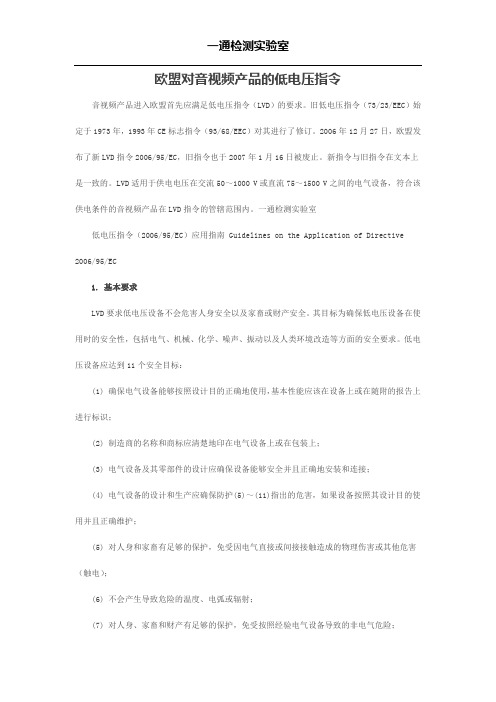
欧盟对音视频产品的低电压指令音视频产品进入欧盟首先应满足低电压指令(LVD)的要求。
旧低电压指令(73/23/EEC)始定于1973年,1993年CE标志指令(93/68/EEC)对其进行了修订。
2006年12月27日,欧盟发布了新LVD指令2006/95/EC,旧指令也于2007年1月16日被废止。
新指令与旧指令在文本上是一致的。
LVD适用于供电电压在交流50~1000 V或直流75~1500 V之间的电气设备,符合该供电条件的音视频产品在LVD指令的管辖范围内。
一通检测实验室低电压指令(2006/95/EC)应用指南 Guidelines on the Application of Directive 2006/95/EC1. 基本要求LVD要求低电压设备不会危害人身安全以及家畜或财产安全。
其目标为确保低电压设备在使用时的安全性,包括电气、机械、化学、噪声、振动以及人类环境改造等方面的安全要求。
低电压设备应达到11个安全目标:(1) 确保电气设备能够按照设计目的正确地使用,基本性能应该在设备上或在随附的报告上进行标识;(2) 制造商的名称和商标应清楚地印在电气设备上或在包装上;(3) 电气设备及其零部件的设计应确保设备能够安全并且正确地安装和连接;(4) 电气设备的设计和生产应确保防护(5)~(11)指出的危害,如果设备按照其设计目的使用并且正确维护;(5) 对人身和家畜有足够的保护,免受因电气直接或间接接触造成的物理伤害或其他危害(触电);(6) 不会产生导致危险的温度、电弧或辐射;(7) 对人身、家畜和财产有足够的保护,免受按照经验电气设备导致的非电气危险;(8) 在可预见的条件下有适当的绝缘保护;(9) 电气设备满足预期的机械性能要求,不会危及人身、家畜和财产;(10) 电气设备在预期的环境条件下能够抵御非机械方面的影响,从而不会危及人身、家畜和财产;(11) 在可预见的过载(过电流)的情况下,电气设备不会危及人身、家畜和财产。
- 1、下载文档前请自行甄别文档内容的完整性,平台不提供额外的编辑、内容补充、找答案等附加服务。
- 2、"仅部分预览"的文档,不可在线预览部分如存在完整性等问题,可反馈申请退款(可完整预览的文档不适用该条件!)。
- 3、如文档侵犯您的权益,请联系客服反馈,我们会尽快为您处理(人工客服工作时间:9:00-18:30)。
欧盟更新低电压LVD指令,发布2014/35/EC指令
更新了低电压LVD指令,发布2014/35/EC指令(on the harmonisation of the laws of the Member States relating to the making available on the market of electrical equipment designed for use within certain voltage limits)指令,替代2006/95/EC。
该指令涵盖了所有交流供电电压为50V~1000V、直流供电电压为75V~1500V的所有用电设备(指令附录2提及的个别设备除外),具体饱含的机电产品有家电设备、照明电器及其附件、音视频设备、信息技术设备、电动工具等。
在2016年4月20日后,所有使用旧低电压指令(2006/95/EC)发的证书都将正式实效作废。
2014/35/EC低电压指令主要变化和内容
2014版低电压指令新规定了以下要求:
1)、在条款1第8项规定,为了便于产品整个经济运行者(包括生产、销售、代理)与市场监管部门、消费者的联系,成员国政府应鼓励经济运行者增加网址信息,作为传统邮政信息的补充。
原文如下:
2)、条款1第9项规定,因制造商对产品的设计、生产最了解,因而制造商是最适合进行产品的合规性评价。
因此,合规性评价义务仅涉及制造商,并且新指令规定合规性评价并不一定须由欧盟公告机构实施。
原文如下:
3)、新指令明确了制造商,进口商和分销商各自的责任;指令第6款为制造商责任;指令第7款为授权代表责任;指令第8款为进口商责任;指令第9款为分销商责任。
4)、在新指令中,电子手段得到更广泛应用,在指令第6款第9项规定,制造商可采用纸质或电子档形式向官方机构提交合规性证明材料。
原文如下:
5)、新指令要求在编制合规性声明(DOC)时,应指出合规性声明仅是制造商的责任,同时,还要求在DOC声明增加可追溯的相关信息,包括些彩色照片信息等。
欧盟指令官方公报的下载地址为:
http://eur-lex.europa.eu/oj/direct-access.html
也可从IDIC(艾迪认证检测)官方网页:的文档下载中心进行下载。
